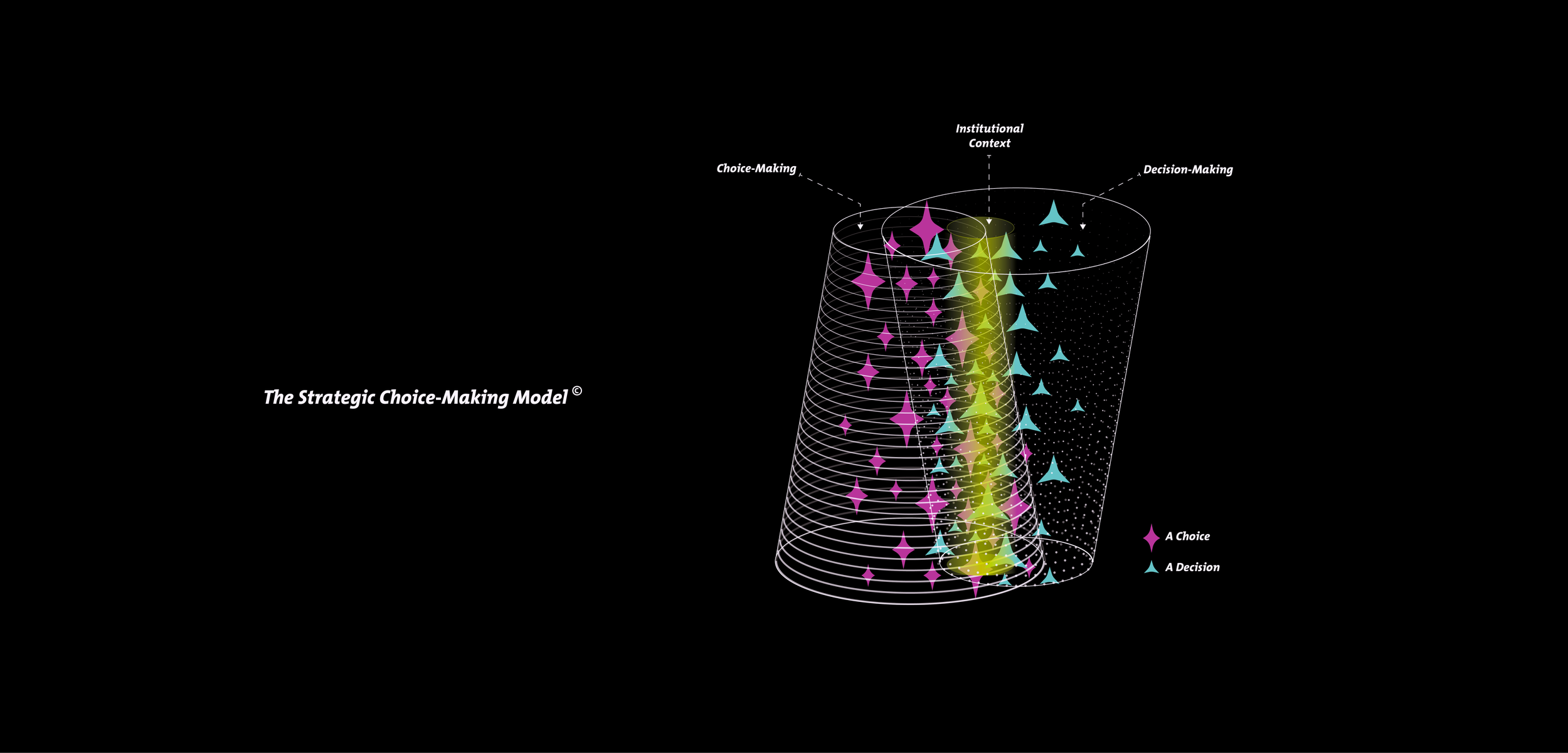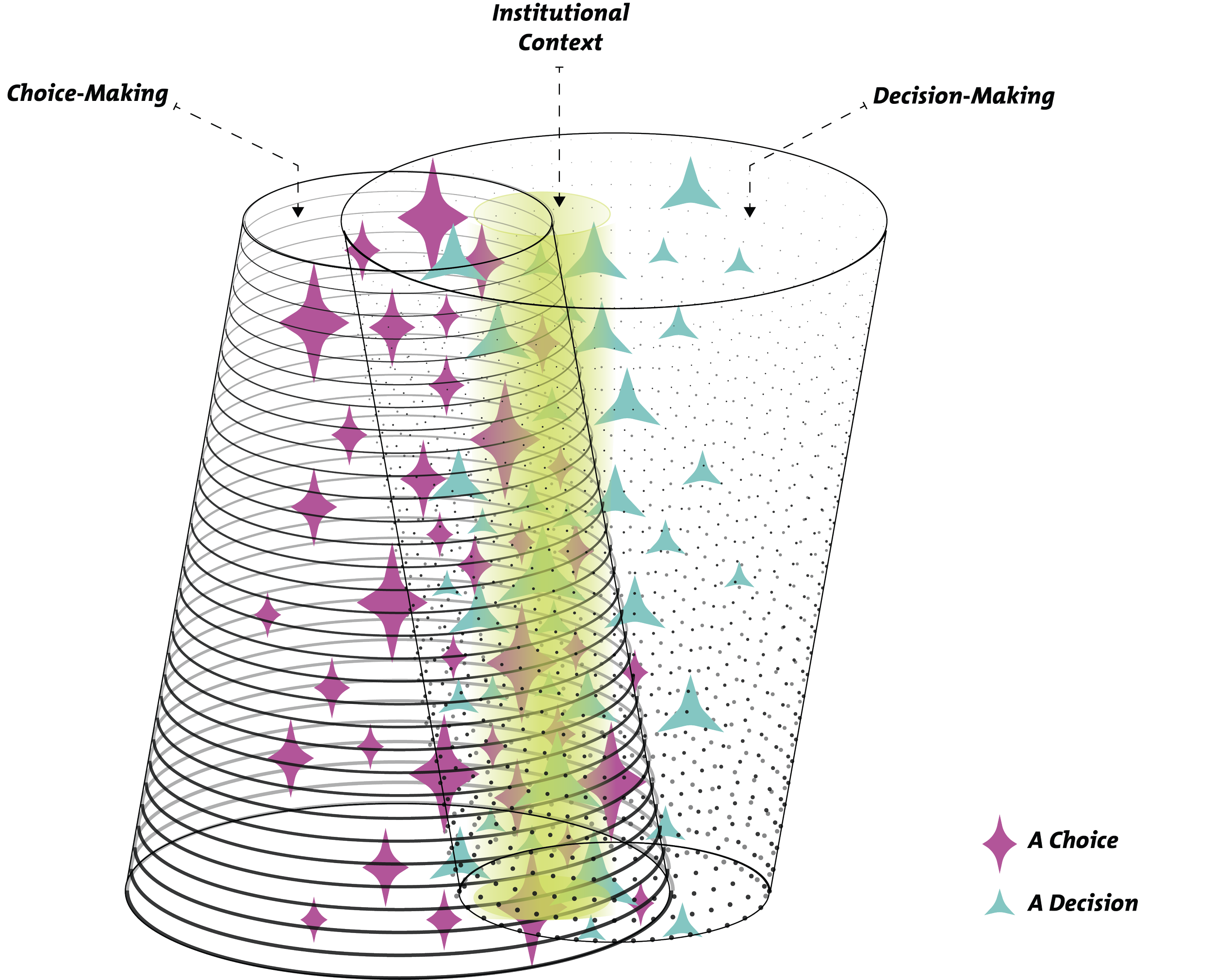
Oct 12, 2025
What is Strategic Choice-Making©?
Turn purpose into features. Navigate systems change.
Related sites
Download dissertation
Authors
Deaa Bataineh
Our institutions were engineered for a 20th-century economy, yet they now face 21st-century forces—sustainability goals, equity demands, digitization, financialization, and shifting economies—that simply out-scale the old logics. In that gap between what our systems can do and what the world now asks of them, new kinds of choices must be made.
Strategic Choice-Making© (SCM) is a design practice for that gap. It helps institutions move from reactive decision-making (“Which familiar option do we pick?”) to intentional choice-making (“What new possibilities must exist—and how do we shape them responsibly?”).
The SCM’s engine is the Strategic Choice-Making Model (SCMM). The Model acknowledges the macro, then works at the micro: it treats features—interfaces, defaults, policies, rules, buy-now-pay-later, or bidirectional charging— as leverage points that mediate flows of money, energy, data, participation, and trust. Redesign the features with intent, and you redirect the flows—and the futures they produce.
When decision-making isn’t enough.
Most institutions are optimized for decision-making: choosing among the known and the visible under fixed constraints. That’s useful, but today’s challenges also demand choice-making: the capacity to frame new paths, reconcile competing logics, and navigate ambiguity.
Strategic Choice-Making fills a critical gap in the design field. It positions designers—and institutional leaders—as agents of direction, not just execution—aligning institutional purpose with the forces that shape our moment.
The Strategic Choice-Making Model
How do we choose the right features to carry the weight of our purpose, given the forces shaping our world?
To answer, SCMM starts by mapping:
Institutional Purpose – Long-term intent that guides what the institution values and invests in.
Macro Forces – Sustainability, equity, digitization, deglobalization, and financialization. These shape the context and constraints.
When purpose meets forces, we design:
Strategic Features – the practical translation of intent, the mediating design elements—interfaces, defaults, policies, rules, offerings—that turn intent into infrastructure.
Flows – The resource, relational, and informational movements that these features carry, redirect, or manage.
Why this approach scales
Across sectors, and when products and services are reframed at the intersections of systems, one pattern holds: features are leverage points. When chosen and combined with intent, they re-orient flows—and futures. Examples of features:
Mobility / Energy
Before: Chargers cluster in affluent areas; grid strained at peaks.
After (features): Equity siting + dynamic pricing + bidirectional charging → revenue to underserved sites, smoother load, better access.Digital Finance
Before: Credit scoring excludes informal workers.
After (features): Alternative ID + contextual credit pathways + transparent data consent → inclusion without predatory risk.
Food Systems (airports, hospitals, schools)
Before: One-size menus; high waste; opaque sourcing.
After (features): Pre-select modules + nearby vertical-farm contracts + waste telemetry → lower waste, local jobs, healthier choices.
Because SCMM measures flows, it lends itself well—from pilots to platforms, from products to policy. It provides a disciplined way to script possibilities so platforms, infrastructures, and institutions can finally keep pace with the futures we deserve..
ABOUT THE AUTHORS:
Deaa Bataineh is a designer, researcher, and consultant specializing in innovation at the intersection of systems, design, and strategy. He holds a PhD from the Institute of Design (ID) at Illinois Institute of Technology, where he developed the Strategic Choice-Making© model. His work addresses complex infrastructures—such as EV charging, emergency response, and digital payments—as platforms for equitable and sustainable transformation. He serves on the Aux Board of the Design Museum of Chicago, co-founded the design department at Jordan University of Science and Technology in Jordan, and hosts the podcast espresso?. For more visit Deaa’s website here.


